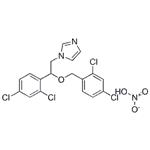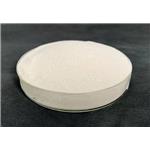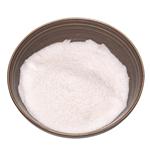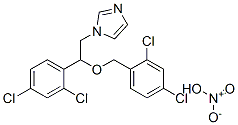- Miconazole nitrate
-

- $33.00 / 1kg
-
2024-04-27
- CAS:22832-87-7
- Min. Order: 1kg
- Purity: 99%
- Supply Ability: g-kg-tons, free sample is available
- Miconazole Nitrate
-

- $0.00 / 1kg
-
2024-04-13
- CAS:22832-87-7
- Min. Order: 1kg
- Purity: 99%
- Supply Ability: 20tons
- Miconazole nitrate
-

- $0.00 / 1kg
-
2023-10-12
- CAS:22832-87-7
- Min. Order: 1kg
- Purity: 0.99
- Supply Ability: 20tons
|
| Product Name: | Miconazole nitrate | | Synonyms: | NSC 169434 Nitrate;1H-Imidazole, 1-[2-(2,4-dichlorophenyl)-2-[(2,4-dichlorophenyl)methoxy]ethyl]-, nitrate (1:1);()-MICONAZOLE NITRATE SALT, IMIDAZO;1-(2,4-Dichloro-β-[(2,4-dichlorobenzyl)oxy]phenethyl)imidazole
1-[2-(2,4-Dichlorobenzyloxy)-2-(2,4-dichlorophenyl)ethyl]-1H-imidazole Nitrate;MICONAZOLE NITRATE USP;MiconazoleNitrate-Bp/Ep/Usp;1-(2,4-dichloro-β-[(2,4-dichlorobenzyl)oxy]phenethyl)imidazole;MICONAZOLE(RG) | | CAS: | 22832-87-7 | | MF: | C18H15Cl4N3O4 | | MW: | 479.14 | | EINECS: | 245-256-6 | | Product Categories: | MONISTAT;API;Aromatics;Heterocycles;Intermediates & Fine Chemicals;Pharmaceuticals;API's;Antifungal;Antifungals for Research and Experimental Use;Biochemistry;Active Pharmaceutical Ingredients;Organics;22832-87-7 | | Mol File: | 22832-87-7.mol |  |
| | Miconazole nitrate Chemical Properties |
| Melting point | 170-185 C | | density | 1.5000 (rough estimate) | | refractive index | 1.6200 (estimate) | | storage temp. | 2-8°C | | solubility | pyridine: soluble50mg/mL | | color | white to off-white | | optical activity | [α]25/D 0°, c = 10 in water | | Water Solubility | Slightly soluble in water. Soluble in propylene glycol or pyridine. | | Merck | 14,6178 | | InChIKey | MCCACAIVAXEFAL-UHFFFAOYSA-N | | CAS DataBase Reference | 22832-87-7(CAS DataBase Reference) |
| Hazard Codes | Xn | | Risk Statements | 22-43-40 | | Safety Statements | 36/37 | | RIDADR | 3249 | | WGK Germany | 3 | | RTECS | NI4771000 | | HazardClass | 6.1(b) | | PackingGroup | III | | HS Code | 2933290000 |
| | Miconazole nitrate Usage And Synthesis |
| Pharmacological effects | Miconazole nitrate is a kind of artificially synthetic 1-phenylethyl imidazole derivatives and belongs to imidazole-class broad-spectrum antifungal drug. It is a commonly used drug for treating skin ringworm without containing hormones and without side effects. Its main active ingredient is miconazole. However, miconazole nitrate is now seldom used in China. Its antibacterial spectrum, antibacterial activity and mechanism of action are all similar with clotrimazole. It can be used as a substitute drug when the treatment of amphotericin in deep fungal infection is invalid. It is suitable for treating the systemic, disseminated infection caused by some kinds of fungus such as Cryptococcus neoformans and Candida albicans. The efficacy of absorption via oral administration is poor. After topical administration, the drug is mainly maintained in the lesion place with only a small fraction getting absorbed into the body. In vivo, it is widely distributed in various body tissues and fluids and can penetrate into the inflamed joints, vitreous and the peritoneum, but the concentration in the sputum and saliva is low and it has a poor penetrating capability through the blood-brain barrier and is difficult to penetrate through the blood-brain barrier. It has a plasma protein binding rate of 90%. It is mainly inactive through liver metabolism into inactive metabolites with 14%~22% of the metabolites being excreted through urine, of which less than 1% of drug being in its prototype. 50% of the drug is excreted through the feces via in its prototype form. The half-life of the α-phase is 0.4 hour while the half-life of the β phase is 2.1 hours with the terminal half-life being 20 to 24 hours.
[Mechanism of action of the miconazole nitrate]
1. It can interfere with the activity of cytochrome P450, inhibit the ergosterol biosynthesis of the fungal cell membrane, causing damage to the fungal cell membrane and changing its permeability, further resulting in the leakage of the important intracellular material.
2. It can inhibit the biosynthesis of the fungal triglyceride and phospholipid.
3. It can inhibit the activity of the oxidase and peroxidase enzyme, resulting in the excessive accumulation of the hydrogen peroxide inside the cell, further leading to the submicroscopic structural degeneration and necrosis of fungus.
4. To candida albicans, it can suppress the process of the transition from spores into aggressive hyphae.
[Antimicrobial spectrum]
Miconazole nitrate has an excellent antifungal effect against various kinds of deep fungi (such as Candida albicans, Aspergillus, Cryptococcus neoformans, blastomycosis, coccidioidomycosis and torulopsis), some epidermis fungi and yeasts. It also has antibacterial effect against some kinds of Gram-positive bacteria (such as staphylococcus, streptococcus) and Bacillus (such as Bacillus anthracis).
[Clinical application]
1. for serious infections caused by Candida species, including peritonitis, pneumonia and urinary tract infections. Miconazole nitrate can also be used for treating the secondary infection caused by the Gram-positive bacteria.
2. The local administration can be used for treating chronic and extensive mucocutaneous candidiasis, vulvovaginitis candidiasis, tinea, ringworm, jork itch, athlete’s foot, tinea versicoeor and paronychomycosis caused by various kinds of dermatophytes, yeast and other kinds of fungus.
3. Intravenous administration of it can be used for treating serious cryptococcosis, coccidioidomycosis and vice coccidioidomycosis.
The above information is edited by the Chemicalbook of Dai Xiongfeng.
| | Antifungals | Miconazole nitrate is a kind of antifungal agent which is the drug ”Dakelin” which we are familiar with as commonly used drugs for treating skin ringworm. It has various kinds of effects. It inhibit the biosynthesis of ergosterol which is the fungal cell membrane component, causing damage to the cell membrane structure, increasing the membrane permeability, resulting in the leakage of the intracellular components and inhibiting the glucose utilization, preventing the nutrient uptake, and finally leading to fungal cell death. It is therefore suitable for the treatment of tinea, jock itch, ringworm, athlete's foot, tinea versicolor and paronychomycosis as well as the vaginal infection and secondary infection caused by the yeast (such as Candida) and Gram-positive bacteria. It is also effective in treating otitis externa and bacterial skin infections.
The common adverse reactions and side effects of miconazole nitrate include: occasional allergy, blisters, burning feeling, redness, itching or other skin irritation. Very rare angioedema, urticaria, eczema, contact dermatitis, erythema, pelvic pain (cramps), vaginal irritation, vaginal secretions and discomfort in the administration site.
| | Drug Interactions | 1. When it is used in combination with anticoagulant drugs such as coumarin or indandione derivative, it can enhance the effects of the later drugs, leading to prolonged prothrombin time. The patient should be subject to close observation and monitoring of prothrombin time as well as adjustment of the dosage of the anti-coagulation drugs.
2. Miconazole nitrate can be used to increase the cyclosporine blood concentration and could increase the risk of renal toxicity. Therefore, when these two drugs are used in combination, we should monitor the blood concentration of cyclosporine.
3. Rifampicin may enhance the metabolism of this product, increase the liver toxicity. When being used in combination with this drug, it can reduce the plasma concentration of this product, leading to the treatment failure. Being used in combination with isoniazid may also reduce the blood concentration of this product. Thus, we should be cautious when use those above drugs in combination with each other.
4. Combination with phenytoin and miconazole nitrate can cause changes in metabolism of these two drugs, and prolong the peak time of this product. When use the two drugs in combination, we should closely monitor their reactions.
5. Combination with hypoglycemic agent can lead to severe hypoglycemia due to inhibit the metabolism of the drug.
6. Combination with cisapride should be tabooed because this can lead to inhibition of the cytochrome P450 metabolic pathways, further causing arrhythmia. There is also risk of arrhythmia when apply miconazole nitrate in combination with astemizole or terfenadin. Therefore, this should also be avoided.
| | Uses | It is a kind of broad-spectrum anti-fungal drug and can be applied to the treatment of deep fungal infections.
| | Description | Miconazole is a widely used antifungal imidazole that acts by inhibiting the 14α-demethylation of lanosterol, which consequently leads to the inhibition of ergosterol synthesis in fungal cell membranes. Additionally, miconazole has been shown to induce reactive oxygen species in fungal biofilms, demonstrating a MIC value of ≥256 μM against Candida spp. | | Chemical Properties | White Solid | | Originator | Daktarin,Janssen,Italy,1974 | | Uses | Miconazole is a widely used antifungal imidazole that acts by inhibiting the 14α-demethylation of lanosterol, which consequently leads to the inhibition of ergosterol synthesis in fungal cell membranes. Additionally, miconazole has been shown to induce reactive oxygen species in fungal biofilms, demonstrating a MIC value of ≥256 μM against Candida spp. | | Uses | An antifungal agent that inhibits platelet cyclooxygenase | | Uses | Antifungal (topical). | | Manufacturing Process | Imidazole is reacted with ω-bromo-2,4-dichloroacetophenone and that product
reduced with sodium borohydride.
A suspension of 10.3 parts of the α-(2,4-dichlorophenyl)imidazole-1-ethanol
thus obtained and 2.1 parts of sodium hydride in 50 parts of dry
tetrahydrofuran is stirred and refluxed for 2 hours. After this reaction time,
the evolution of hydrogen is ceased. Then there are added successively 60
parts dimethylformamide and 8 parts of 2,4-dichlorobenzyl chloride and
stirring and refluxing are continued for another 2 hours. The tetrahydrofuran
is removed at atmospheric pressure. The dimethylformamide solution is
poured onto water.
The product, 1-[2,4-dichloro-β-(2,4 -dichlorobenzyloxy)phenethyl]imidazole, is
extracted with benzene. The extract is washed with water, dried, filtered and
evaporated in vacuo. From the residual oily free base, the nitrate salt is
prepared in the usual manner in 2-propanol by treatment with concentrated
nitric acid, yielding, after recrystallization of the crude solid salt from a
mixture of 2-propanol, methanol and diisopropyl ether, 1-[2,4-dichloro-β-
dichlorobenzyloxy)phenethyl]imidazole nitrate; melting point 170.5°C. | | Brand name | M-Zole (Actavis); Monistat (Ortho-McNeil); Monistat (Personal Products); Monistat (Johnson & Johnson). | | Therapeutic Function | Antifungal | | General Description | Pharmaceutical secondary standards for application in quality control, provide pharma laboratories and manufacturers with a convenient and cost-effective alternative to the preparation of in-house working standards. Miconazole nitrate is an imidazole derivative and a broad spectrum antifungal drug used in the management of fungal outbreak in humans and veterinary animals. | | Biological Activity | Antifungal agent. Inhibits lanosterol demethylase and induces formation of reactive oxygen species. | | Biochem/physiol Actions | Miconazole interacts with 14-α demethylase, a cytochrome P-450 enzyme necessary for ergosterol biosynthesis. The inhibition of ergosterol results in increased cellular permeability causing leakage of cellular contents. Miconazole may also inhibit endogenous respiration, interact with phospholipids in the cell membrane, inhibit the transformation of yeasts to mycelial forms, inhibit purine uptake, and interfere with triglyceride and phospholipid biosynthesis. | | Clinical Use | 1-[2-(2,4-Dichlorophenyl)-2-[2,4-dichlorophenyl]-methoxy]ethyl]-1H-imidazole mononitrate (Monistat,Micatin) is a weak base with a pKa of 6.65. The nitric acidsalt occurs as white crystals that are sparingly soluble inwater and most organic solvents.
The free base is available in an injectable form, solubilized with polyethylene glycol and castor oil, and intended for the treatment of serious systemic fungal infections, such as candidiasis, coccidioidomycosis, cryptococcosis, petriellidiosis, and paracoccidioidomycosis. It may also be used for the treatment of chronic mucocutaneous candidiasis. Although serious toxic effects from the systemic administration of miconazole are comparatively rare, thrombophlebitis, pruritus, fever, and gastrointestinal upset are relatively common. Miconazole nitrate is supplied in various dosage forms (cream, lotion, powder, and spray) for the treatment of tinea infections and cutaneous candidiasis. Vaginal creams and suppositories are also available for the treatment of vaginal candidiasis. A concentration of 2% of the salt is used in most topical preparations. |
| | Miconazole nitrate Preparation Products And Raw materials |
|